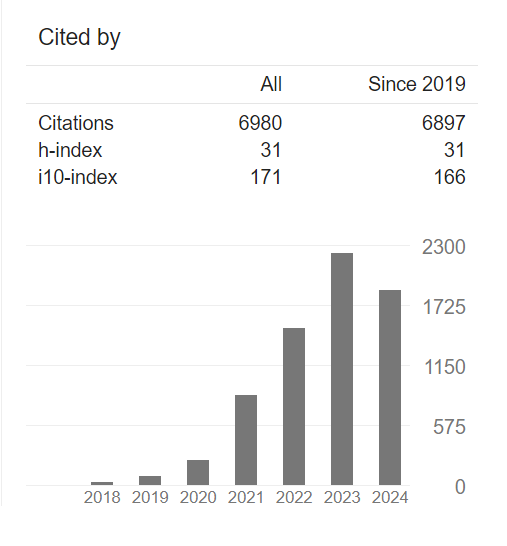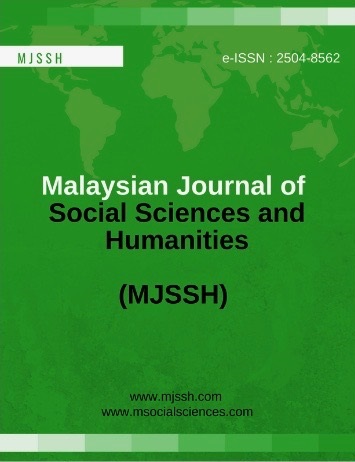Sectoral Distribution and Trends in Mandated Corporate Social Responsibility Spending: A Case Study of Coimbatore, India
Abstract
Mandated Corporate Social Responsibility in India requires eligible companies to allocate 2% of their profits annually towards CSR spends. These expenditures must be publicly reported, and the Ministry of Corporate Affairs of India publishes this data to ensure transparency. The Companies Act 2013 regulates expenditure areas across development sectors aligned with the national agenda. Despite government-listed sectors, companies may prioritize spending freely. As mandated CSR in India approaches a decade, understanding CSR spend patterns and trends is crucial. This paper analyzes CSR spending trends in Coimbatore using secondary data from the National CSR Data Portal. A statistical analysis explores trends in total contributions across various sectors by year, identifying key focus areas for each fiscal year. The study underscores
corporate priorities and highlights the necessity for continuous monitoring of CSR expenditure trends. The implications are significant for policymakers contributing to informed decision making and maximizing social impact.
Downloads
References
Arevalo, J. A., & Aravind, D. (2011, August). Corporate social responsibility practices in India: approach, drivers, and barriers. Corporate Governance: The international journal of business in society, 11(4), 399–414. https://doi.org/https://doi.org/10.1108/14720701111159244
Asian Development Bank. (2024). Tamil Nadu Urban Flagship Investment Program (Tranche 3). Asian Development Bank, South Asia Department/ Urban Development and Water Division (SAUW). Manila: Asian Development Bank. Retrieved September 27, 2025, from https://www.adb.org/projects/documents/ind-49107-010-smr-1
Bergman, M. M., Bergman, Z., Teschemacher, Y., Arora, B., Jyoti, D., & Sengupta, R. (2019, October). Corporate Responsibility in India: Academic Perspectives on the Companies Act 2013. Sustainability, 11(21), p. 5939. https://doi.org/https://doi.org/10.3390/su11215939
Carroll, A. B., & Buchholtz, A. K. (2003). Business and society: Ethics and stakeholder management (5th ed.). South-Western College Publishing (Thomson Learning).
Chapple, W., & Moon, J. (2005). Corporate social responsibility (CSR) in Asia: A seven-country study of CSR web site reporting. Business & Society, 44(4), 415–441. https://doi.org/https://doi.org/10.1177/0007650305281658
Chatterjee, B., & Mitra, N. (2016). CSR Implementation: How It Is Done in India. In B. Chatterjee, N. Mitra, N. Mitra, & R. Schmidpeter (Eds.), Corporate Social Responsibility in India (pp. 71-77). Springer. https://doi.org/10.1007/978-3-319-41781-3_6
Elkington, J. (1998). Cannibals with Forks: The Triple Bottom Line of 21st Century Business (The Conscientious Commerce Series). New Society Publishers. https://books.google.com/books/about/Cannibals_with_Forks.html?id=dIJAbIM7XNcC
Elumelu, T. O. (2014). CSR as an anti-poverty instrument. Retrieved September 27, 2025, from Business Line. https://www.thehindubusinessline.com/opinion/csr-as-an-anti-poverty-instrument/article22995727.ece
Freeman, R. E., & Reed, D. L. (1983). Stockholders and Stakeholders: A New Perspective on Corporate Governance. California Management Review, 25(3), 88-106. https://doi.org/https://doi.org/10.2307/41165018
Government of India. (1956). The Companies Act, 1956 (Act No. 1 of 1956). New Delhi: Ministry of Law and Justice. https://www.indiacode.nic.in/bitstream/123456789/12807/1/the_companies_act%2C_1956_no._1_of_1956_date_01.01.1956.pdf
Govindarajulu, R. (2014). What transformed Coimbatore into the Manchester of South India. Retrieved September 27, 2025, from The Textile Magazine. https://www.indiantextilemagazine.in/spinning/what-transformed-coimbatore-into-the-manchester-of-south-india/
Kolstad, I. (2007). Why firms should not always maximize profits. Journal of Business Ethics, 76(2), 137-145. https://doi.org/https://doi.org/10.1007/s10551-006-9262-7
Kugelman, M., & Banaji, F. (2015, March 25). What Can Be Done to Strengthen India’s Natural Resource Management?. Retrieved September 27, 2025, from newsecuritybeat. https://www.newsecuritybeat.org/2015/03/strengthen-indias-natural-resource-management-part-2-2/
Lakshman, A. (2023, September). India ageing, elderly to make up 20% of population by 2050: UNFPA report. United Nations Population Fund (UNFPA) India. New Delhi: United Nations Population Fund (UNFPA) India. Retrieved April 20, 2025, from India UNFPA. https://india.unfpa.org/en/news/india-ageing-elderly-make-20-population-2050-unfpa-report
Liu, B. (2020). China’s Green Investment in Africa: A State-Centric Corporate Social Responsibility Perspective. Transnational Environmental Law, 10(1), 57–84. https://doi.org/https://doi.org/10.1007/978-981-99-5215-6
Meghani, A., Palanisamy, B., Singh, S., Singh, T., Kanagat, N., Gupta, A., Singh, K., & Soni, G. K. (2025). The Role of Partnerships in Supporting COVID-19 Vaccine Uptake Among Migrants: A Qualitative Case Study from Tamil Nadu and Punjab, India. Vaccines, 13(1), 62. https://doi.org/https://doi.org/10.3390/vaccines13010062
Ministry of Corporate Affairs. (2025, September 27). Dynamic CSR Report. National CSR Data Portal. https://www.csr.gov.in
Ministry of Jal Shakti. (2025). Namami Gange Programme: Restoring the divine glory of River Ganga. Press Information Bureau. Retrieved September 27, 2025, from https://pib.gov.in/PressReleasePage.aspx?PRID=2109118
Mitra, N. (2021). Impact of strategic management, corporate social responsibility on firm performance in the post mandate period: evidence from India. International Journal of Corporate Social Responsibility, 6(1), 1-15. https://doi.org/https://doi.org/10.1186/s40991-020-00052-4
Mitra, N., & Schmidpeter, R. (2020). Mandated Corporate Social Responsibility: Evidence from India (1 ed.). Springer. https://doi.org/https://doi.org/10.1007/978-3-030-24444-6
NITTTR. (2013). Slum free city plan for action- Coimbatore Corporation. Chennai: Coimbatore City Municipal Corporation.
Planning Commission, Government of India. (2013). Twelfth Five Year Plan (2012–2017): Faster, More Inclusive and Sustainable Growth. New Delhi: SAGE Publications India Pvt Ltd. https://archive.org/details/twelfthfiveyearp0000indi
Rahman, S. (2006). Development, Democracy and the NGO Sector. Journal of Developing Societies, 22(4), 451–473. https://doi.org/https://doi.org/10.1177/0169796X06072650
Revathy, N., Thilagavathi, M., & Surendran, A. (2020). A Comparative Analysis of Rural-Urban Migrants and NonMigrants in the Selected Region of Tamil Nadu, India. Economic Affairs, 65(1), 23-30. https://doi.org/https://doi.org/10.30954/0424-2513.1.2020.4
Saeed, M. M., & Arshad, F. (2012). Corporate social responsibility in Pakistan: A sectoral analysis. African Journal of Business Management, 6(2), 453-467. https://doi.org/https://doi.org/10.5897/AJBM11.2482
Sanclemente-Téllez, J. C. (2017). Marketing and corporate social responsibility (CSR): Moving between broadening the concept of marketing and social factors as a marketing strategy. Spanish Journal of Marketing - ESIC, 21(S1), 4-25. https://doi.org/https://doi.org/10.1016/j.sjme.2017.05.001
Sundar, P. (1996). Women and philanthropy in India. VOLUNTAS: International Journal of Voluntary and Nonprofit Organizations, 7(4), 412-427. https://doi.org/https://doi.org/10.1007/BF02354162
Synopsys India. (2024). Corporate Social Responsibility Annual Report FY 2023–24. Synopsys India. https://www.synopsys.com/content/dam/synopsys/company/company-pdfs/csr-india-annual-report-fy24.pdf
Türker, D. (2013). Developing an instrument to measure the social responsibility of corporations: CSR scale. Journal of Business Ethics, 85(4), 411-427. https://doi.org/https://doi.org/10.1007/s10551-008-9780-6
Vasavda, M., & Ranjan, A. (2017, July 14). Government aims high in bid to make India a sporting nation. Retrieved September 27, 2025, from Indian Express. https://indianexpress.com/article/sports/sport-others/government-aims-for-the-moon-in-bid-to-make-india-a-sporting-nation-4749555/
Visser, W., Matten, D., Pohl, M., & Tolhurst, N. (2008). The A to Z of Corporate Social Responsibility: A Complete Reference Guide to Concepts, Codes and Organisations. John Wiley & Sons. https://doi.org/https://doi.org/10.1002/9781119205944.fmatter
Wan-Jan, W. S. (2006). Defining corporate social responsibility. Journal of Public Affairs, 6(3-4), 176-184. https://doi.org/https://doi.org/10.1002/pa.227
World Economic Forum. (2013). The Global Gender Gap Report. Switzerland: World Economic Forum. Retrieved September 27, 2025, from https://www.weforum.org/publications/global-gender-gap-report-2013/
Yemokhya, F., & Buragohain, B. (2015). CORPORATE SOCIAL RESPONSIBILITY: A REVIEW of Literature. Paripex – Indian Journal of Research, 4(2), 166-176. https://doi.org/

















